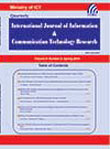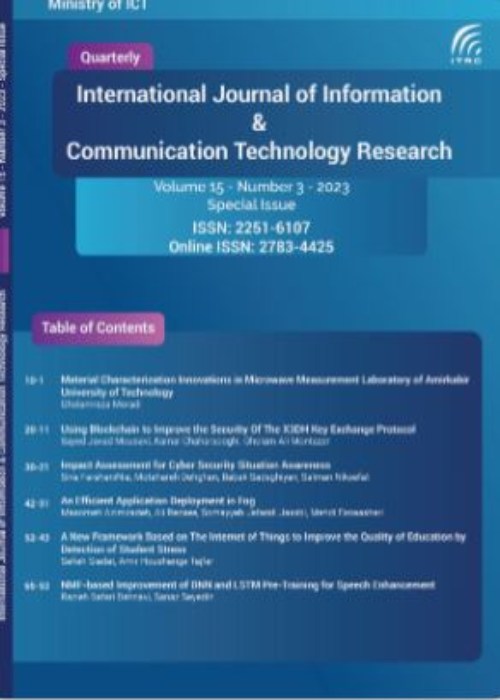فهرست مطالب

International Journal Information and Communication Technology Research
Volume:8 Issue: 2, Spring 2016
- تاریخ انتشار: 1395/03/20
- تعداد عناوین: 8
-
-
Pages 1-7Analyzing motion patterns in traffic videos can directly lead to generate some high-level descriptions of the video content. In this paper, an unsupervised method is proposed to automatically discover motion patterns occurring in traffic video scenes. For this purpose, based on optical flow features extracted from video clips, an improved Group Sparse Topical Coding (GSTC) framework is applied for learning semantic motion patterns. Then, each video clip can be sparsely represented by a weighted sum of learned patterns which can further be employed in very large range of applications. Compared to the original GSTC, the proposed improved version of GSTC selects only a small number of relevant words for each topic and hence provides a more compact representation of topic-word relationships. Moreover, in order to deal with large-scale video analysis problems, we present an online algorithm for improved GSTC which can not only deal with large video corpora but also dynamic video streams. Experimental results show that our proposed approach finds the motion patterns accurately and gives a meaningful representation for the video.Keywords: Motion patterns, Group Sparse Topical Coding, traffic scene
-
Pages 9-14In this paper, a new transaction protocol based on electronic cash using a modified ElGamal signature and a secure blind signature scheme is proposed. With the extension of untraceable electronic cash, a fair transaction protocol is designed which can maintain anonymity and double spender detection and attaches expiration date to coins so that the banking system can manage its databases more efficiently. The security of the system is based on discrete logarithm problem and factoring problem.Also our protocol has better performance than similar protocols. So the new protocol is very efficient.Keywords: digital signature, blind signature, ElGamal digital signature, RSA, electronic payment system, electronic voting system
-
Pages 15-21During DDoS attack to a cloud hosted server, to counter the attack, more resources should be assigned to it. In this paper we first develop a mathematical formula for input packet rate during DDoS attack, and propose a method to identify the botnet that created the attack. We introduce two algorithms for resource assignments to protect cloud hosted servers. The drift plus penalty algorithm minimizes the average cost of resource assignment, and stabilizes the queue size. The modified version of this algorithm is drift plus extended penalty, which minimizes the average cost and compensate penalty function by considering delay.Keywords: DDoS generated traffic modeling. Cloud computing. Drift plus penalty. Drift plus extended penalty. Dynamic resource allocation
-
Pages 23-31During the last decade, scholars have paid a lot of attention to the Mobile Recommender Systems in tourism industry. With reducing information overload and narrowing the results according to tourists'' characteristics and conditions, these systems lead to the development of tourism industry. These recommendations are in the form of multimedia contents, context-aware services, comments and points of peer users, travel schedule and etc. Recent advances in mobile and computing technologies has created more opportunities for detailed and personal recommendations, through historical and contextual parameters. This paper studies Recommender System''s models and techniques in order to propose a new architecture for a Recommender System in tourism. The proposed architecture uses hybrid filtering technique, contextual information of the user, and Model-View-Controller architecture. Also our proposed architecture covers many gaps in previous studies. After that, the design and implementation of a mobile phone application associated with this architecture was examined. Based on The 3-layered Model-View-Controller architecture and Client-Server architecture, its development has taken place. In addition to location and map services using Google Maps API, place suggestion services are offered to users, that here, a private host and domain is used.Keywords: Recommender Systems, Mobile tourism, Hybrid filtering, Model View Controller architecture, Personalization
-
Pages 33-44To reduce the number of input features to a prosody generator in natural speech synthesis application, a hybrid of an evolutionary algorithm and a swarm intelligence-based algorithm is used for feature selection (FS) in this study. The input features to FS unit are word-level and syllable-level linguistic features. The word-level features include punctuation information, part-of-speech tags, semantic indicators, and length of the words. The syllable-level features include the phonemic structure and position indicator of the current syllable in a word. A modified Elman-type dynamic neural network (DNN) is used for prosody generation in this study. The output layer of this DNN provides prosody information at the syllable-level including pitch contour, log-energy level, duration information, and pause data. Simulation results show that the prosody information is predicted with an acceptable error by this hybrid softcomputing method as compared to Elman-type neural network prosody generator and binary gravitational search algorithm-based FS unit.Keywords: speech synthesis, genetic algorithm, ant colony optimization, neural network, prosody
-
Pages 45-51A dynamic threshold secret sharing (DTSS) scheme allows the secret to be updated without changing the shares. The first DTSS scheme was proposed by Laih et al. in 1991. Several other schemes based on different methods have been proposed since then. In 2007, Chen et al. proposed a verifiable DTSS scheme based on elliptic curves and bilinear maps, which is almost efficient. In this paper, we propose an alternative verifiable DTSS scheme using elliptic curves and bilinear maps. The proposed scheme is computationally secure, and the secret and/or threshold parameter can change to any arbitrary values multiple times. Furthermore, in our scheme, there is no secure channel and participants do not need to save any information or extra shares ahead of time. Since the running time is an important factor for practical applications, we provide a complexity comparison of our approach with respect to Chen et al.s scheme. The comparison between the proposed scheme and that of Chen et al. indicates that the new scheme is more efficient, that it means, it has much lower computational complexity, as well as smaller storage requirements.Keywords: Dynamic threshold secret sharing, Elliptic curve, Bilinear pairing, Verifiable, Computational security
-
Pages 53-63Recommender systems are gaining a great importance with the emergence of E-commerce and business on the internet. Collaborative Filtering (CF) is one of the most promising techniques in recommender systems. It uses the known preferences of a group of users to make recommendations for other users. Regardless of its success in many application domains, CF has main limitations such as sparsity, scalability and new user/item problems. As new direction, semantic-based recommenders have emerged that deal with the semantic information of items. Such systems can improve the performance of classical CF by allowing the recommender system to make inferences based on an additional source of knowledge. Moreover, the incorporation of demographic data in recommender systems can help to improve the quality of recommendations. In this paper, we present a new hybrid CF approach that exploits Semantic Web Technology as well as demographic data to alleviate all the problems mentioned above. The experimental results on the MovieLens dataset verify the effectiveness and efficiency of our approach over other benchmarks.Keywords: component, recommender system, collaborative filtering, semantic Web, demographic data, e, commerce
-
Pages 64-65This electronic document is a live template. The various components of your paper [title, text, heads, etc.] are already defined on the style sheet, as illustrated by the portions given in this document. (Abstract should not be longer than 150 words).Keywords: component_formatting_style_styling_insert (Include 5 to 10 words. )


